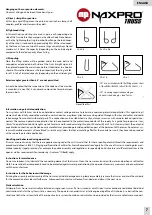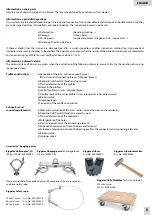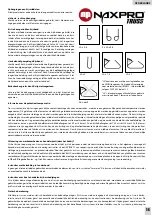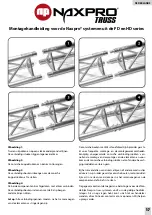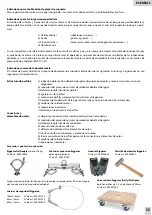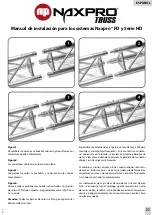
6
Operating and installation instructions for truss systems
Instructions for transportation
The trusses must be sufficiently secured against slipping during transport. Make sure a uniform distribution of the load is given. This
applies particularly when the charge of heavy objects is different. Eventually the charge needs to be labelled. Please follow the traffic
regulations!
Handling and behaviour during assembly and disassembly
In principle by all parties, the personal protective equipment and the applicable laws and regulations must be held in with regard to
the prevention of accidents. The installation of trusses must be performed by competent persons and need to be carried out based
on this instructions / user information. The stability and load capacity must be ensured at all times. All components (truss elements,
connectors, etc.) must be subjected to a visual inspection prior to installation.
In apparent shortcomings such as plastic deformation or material reduction in the main belt and braces, cracks of or beside welds,
slot formation on joints or their anchorages, deformation of these connectors these parts may not installed and have to be marked in
such way that a further erroneous use is excluded. The installation of the trusses must be in the correct direction. For the installation
and removal only suitable tools may be used, e.g. aluminum, plastic or copper hammers, box wrenches and / or ignition wrenches.
Instruction on the correct assembly of the system elements
For this information, see the installation instructions on the back of this leaflet.
Instructions for attaching (induction and recovery of forces)
Under application of force all forms of force and actions are to be understood, which induce a force to a truss or discharge force to a
suspension element. The type and design of the application of force in trusses are largely determined by the actual capacity of the
used truss.
Force of payloads:
The introduction of loads must be in accordance with the manufacturer‘s instructions. When inducing payloads you should consider
that all loads act vertically and are evenly distributed over the main straps. A purely one-sided burden can significantly reduce the
bearing capacity of the truss. An additional horizontal load should be avoided, as the simultaneous combination of vertical and hori-
zontal loads may exceed the allowable stress of the truss. For the event that this additional expense can not be avoided it is essential
to make sure to use trusses whose design allows horizontal loads. When accompanied by horizontal and vertical loads a separate
static proof is necessary.
Content: • Intended use
• Transport
• Installation and dismantling
• Assembly
• Striking
• Potential equalization
• Operation
• Maintenance
• Damages
• Spare parts
• Tests
• Discard criteria
• Structural analysis
Preamble:
Congratulations on your purchase of this truss system from our
range. Following the SQP1 of VPLT we have created this manual.
READ THIS CAREFULLY AND FOLLOW THE INSTRUCTIONS
LISTED. ONLY CONSIDERING OUR INFORMATION MAKES A
SAFE OPERATION WITH THE TRUSS SYSTEMS POSSIBLE!
Intended Use
Trusses and truss constructions are strictly intended to be used
for receiving primarily static loads or purely decorative purpos-
es. They can be hung, placed, permanently mounted or movable
be used.
ENGLISH
Содержание SD Series
Страница 22: ...22 SQP1 VPLT...
Страница 25: ...25 Naxpro FD HD 1 2 3 4 R M8 Naxpro Truss...







